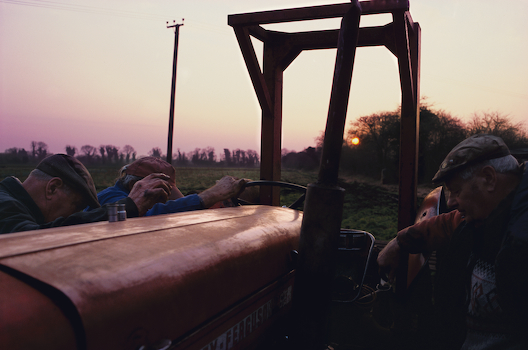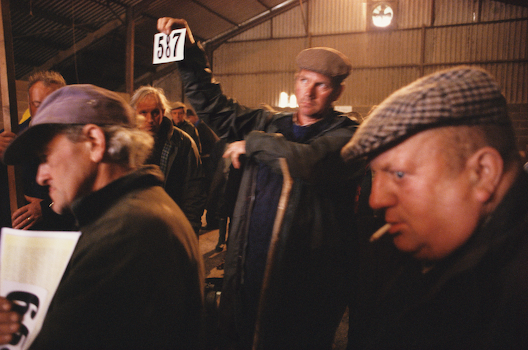Justin Partyka’s photographs of a vanishing world of rural life in East Anglia – farming families and rural workers whose way of life is as much of the soil as the beet and reed they grow – first came to prominent public attention as part of a group show A Picture of Britain at Tate Britain in 2005 and subsequently at a solo show at the Sainsbury Centre in Norwich in 2009.
Many of these images are part of a new group show With a Conscious Eye which opens at Osborne Samuel, Bruton Street, London, on the 5th December. Justin’s images – of muddy fields and farm kitchens, of men lifting sugar beet, of a hedgerow on a grey winter’s day – explore the interdependent relationship of man and landscape, the way the two rub up against and shape each other.
On behalf of Caught by the River Charles Rangeley-Wilson caught up with Justin to ask a few questions about his work:
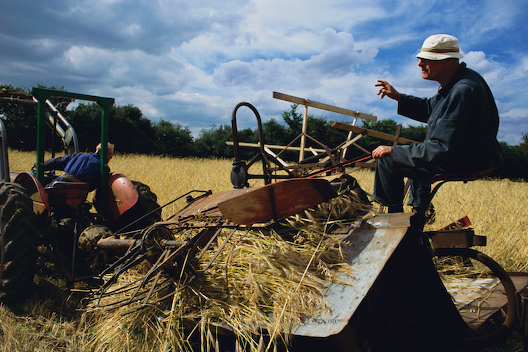 Harvest with binder, Suffolk, 2007
Harvest with binder, Suffolk, 2007
CRW: You trained as a folklorist in Newfoundland, Canada before coming back to England and working on your first well-known series of photographs Field Work – an immersive study of rural life in East Anglia. Tell us how your interest in folklore translated itself to your work as a photographer.
JP: I would not be a photographer if I had not had that time at graduate school in Newfoundland. I went there because of an interest in old-time music of the American South. I had discovered the work of John Cohen. His seminal LP, Mountain Music of Kentucky (1960) combined field recordings with photography and ethnographic writing and delved deep into the aesthetics of how life in the rural mountains shaped the music. It was such an exciting time for me, I was just following a natural path of exploration and discovery and it felt right.
At first I saw the camera as just one of the tools folklorists used for their fieldwork, along with the tape recorder. There was something about the experience of taking photographs during my fieldwork that was very pleasing. It felt like a very natural way to tell a story and explore something. The photograph of the dead rabbit hanging in the tree with the rabbit catcher in the bottom corner came from my MA dissertation The Occupational Folklife of a Norfolk Rabbit Catcher, and this one photograph was beginning of the ten-year long project that became Field Work.
There is no question that photography found me, I did not find it.
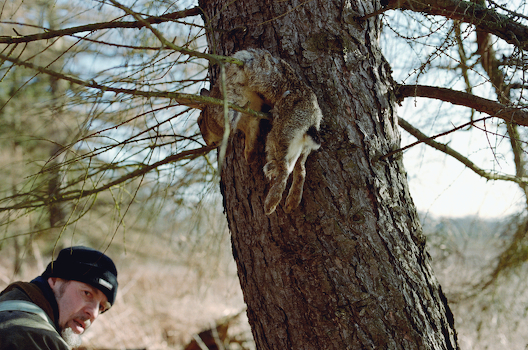 Rabbit catcher, Norfolk, 2001
Rabbit catcher, Norfolk, 2001
CRW: Your pictures seem to me to fit into a wider movement of cultural enquiry – the exploration of place and the way people relate to their landscape. Do you follow the work of other artists and poets and writers? And why do you think this movement exists here and now?
I’m not sure I’d consider it a movement and I haven’t consciously tried to be part of it. When you look at the number of books published in recent years and the events, perhaps it is more of an industry. The New Nature Writing edition of Granta magazine contributed to the idea that there is a movement, but a movement has to form within with a solidarity of its members. Here it was a disparate group of writers, photographers and artists thrown together to suggest something new was taking place. So, I can see why you would fit my work into this movement, but the collaboration with Robert Macfarlane (in Granta) and the photographs I made at the home of Roger Deakin are as far as the link goes. If nature writing is part of a movement, it is difficult to fit photography in there because there has yet to be a meaningful engagement with photography from these writers. When this movement shows a respect for and understanding of photography in the way somebody like Geoff Dyer has, perhaps we can reconsider photography’s place within it.
As to why there is this exploration of place and our connection to landscape right now – it has been a subject for a long time. The digital age just makes it seem more prominent and the Caught by the River website is a good example of that. The cultural, social and economic decline we are all having to deal with has perhaps influenced a few more people to seek out something meaningful. Establishing a connection to place and landscape is a natural way to do that – a way to try and feel “alive” as the world crumbles around us.
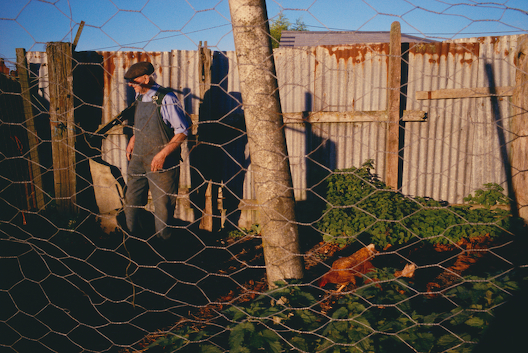 Feeding the chickens, Norfolk
Feeding the chickens, Norfolk
As for the work I follow, from this region of East Anglia the literature that has true relevance for me is the earlier writing: the books by George Ewart Evans, Rider Haggard, Henry Williamson’s The Story of a Norfolk Farm, and of course Baker’s The Peregrine, which I consider to be the last great writing about the East Anglian landscape; and that was first published in 1967!
CRW: I read in your new exhibition introduction that you admire Van Gogh. Van Gogh found beauty in the ordinary and your photographs try to do the same. Tell us a bit about your relationship with artists like Van Gogh.
Nobody has understood how to see the fields and the people who inhabit them better than Vincent. You look at the paintings and you can just see that he got it: the intimate connection between man and the land which comes from a life of working the soil, the way light paints the landscape with amazing colour, and how the fields and the trees really appear when you look at them hard enough and what it feels like emotionally to be there. I see all of this in this paintings. I’ve seen exactly those same everyday scenes in East Anglia and there is something about them that makes me want to photograph them. I should say that when I photograph I am never trying to replicate his paintings, I’m just trying to do my own thing. Although if people see connections between my work and his, that’s good too.
CRW: One thing I like about your photographs is the way they are both immediate, and timeless, kind of statuesque. You seem to get in close with a wide-angle lens and catch moments, but the wider image gives gravity. Tell us a bit about your technique.
It could be because photography is such a democratic medium there is an assumption that if people know the “secret” behind a photograph, they can take one just like it. But it is very difficult to answer these kinds of questions about how I produce my photographs: it is all very subjective. It is not something I can put into words, mainly because I don’t know what will result in a successful photograph until it happens. A successful photograph is one that I have never seen before, something new that has all the elements of composition, light and colour working together. All the time I’m exploring the subject looking for moments when this could happen, trying to get the good photographs by using the camera like one would a sketch pad. Occasionally everything falls into place, and there is what you could call a sublime moment. It can be very the subtle and minute details in a photograph that make it a great one.
I use a 35mm lens, and very occasionally a 28mm. My camera is a Leica M6. I only use Fuji Provia 35mm transparency film. I typically use about 300 – 500 rolls of film a year. This might sound like a lot, but it’s not really. I’m never photographing randomly. Each time I press the shutter button it is with a purpose. To give a sense of the extent of my work, just last week at the Suffolk Salon that I host with my partner Bee Farrell, I projected a carousel of 80 slides from Field Work, and most of these were unseen outtakes. But they were strong enough photographs that any of them could easily be included in the final edit.
CRW: I’m curious also about how you build relationships with the subjects of your images. That must take a lot of time, but also, perhaps, be as rewarding as the images themselves. Tell us about the people.
When I reflect back on the Field Work project really I just feel like I stumbled into the lives of these farmers and became deeply immersed. It is inevitable that if you visit somebody regularly over a number of years you will become good friends with them. I was visiting some of these farmers at least weekly and they are people I became very close to and who I am still in touch with. The generosity, kindness and trust I received from these farmers was very humbling, and they are the most honest and reliable people I have had the pleasure to know. It has also been a relationship of mutual respect as we have learned about each other. Just as they shared their world with me, I’ve tried to share my world with them, inviting them to exhibitions and keeping them involved with the project now it is out there being seen.
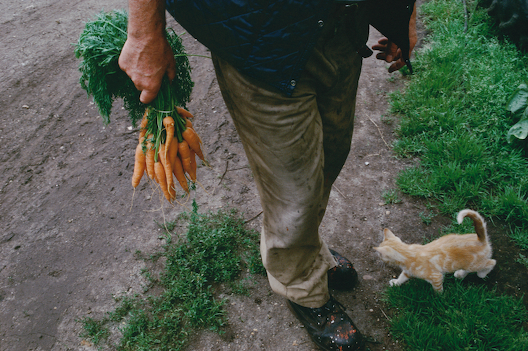 Carrot harvest, Norfolk, 2006
Carrot harvest, Norfolk, 2006
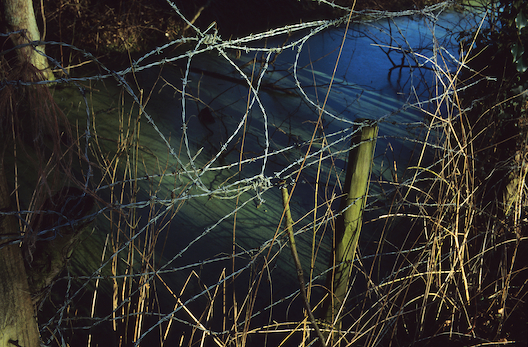 River Nar Valley, Norfolk, 2010
River Nar Valley, Norfolk, 2010
CRW: Finally tell us about your current work. You’ve been studying Norfolk fields in a way that reminds me of Tim Dee’s new book.
In 2009 as the Field Work project was reaching a conclusion I drifted towards photographing what I call ‘unpeopled’ landscapes. It started with photographs of a floodplain on the Wash in Norfolk and has evolved into a number of loosely linked projects, which include the River Nar valley, photographs of my childhood landscape in West Norfolk, a two-year long exploration of a small wood and a surrounding field. What links all of this work is a fascination with the rural agricultural landscape of East Anglia and an attempt to intimately explore my own relationship to it.
At the heart of it all is an obsession to know the place I am from.
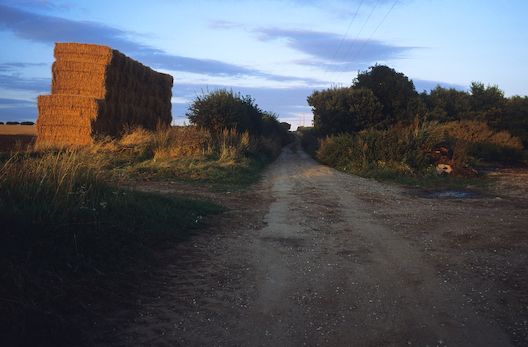 Farm track, Norfolk, 2012
Farm track, Norfolk, 2012
With a Conscious Eye: An Exhibition of Three Photographers – David Constantine, Nick Danziger, Justin Partyka
5 – 21 December, 2013, Osborne Samuel, 23a Bruton Street, London, W1J 6QG
Caught by the River readers are invited to attend the exhibition Private View on Wednesday 4th December, 6-8pm. Please RSVP Jessica Mander at the gallery by telephone or email jmander@osbornesamuel.com
More details about Justin can be found at justinpartyka.com
